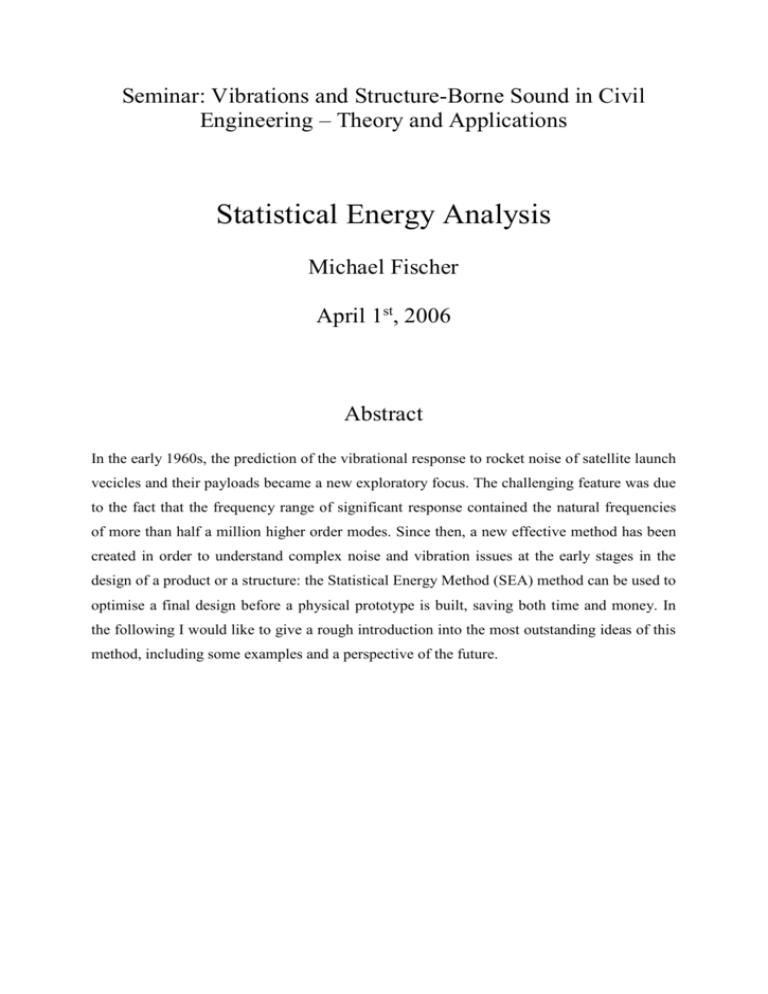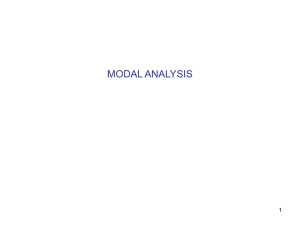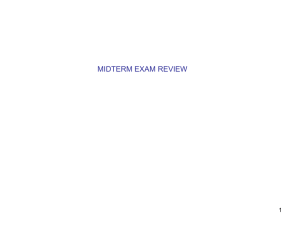Statistical Energy Analysis
advertisement

Seminar: Vibrations and Structure-Borne Sound in Civil Engineering – Theory and Applications Statistical Energy Analysis Michael Fischer April 1st, 2006 Abstract In the early 1960s, the prediction of the vibrational response to rocket noise of satellite launch vecicles and their payloads became a new exploratory focus. The challenging feature was due to the fact that the frequency range of significant response contained the natural frequencies of more than half a million higher order modes. Since then, a new effective method has been created in order to understand complex noise and vibration issues at the early stages in the design of a product or a structure: the Statistical Energy Method (SEA) method can be used to optimise a final design before a physical prototype is built, saving both time and money. In the following I would like to give a rough introduction into the most outstanding ideas of this method, including some examples and a perspective of the future. Contents 1 1.1 1.2 1.3 Introduction Methods Used for Vibration Problems Introductory Example Historical Example 3 3 4 5 2 Motivation for Statistical Energy Analysis 6 3 Deterministic Approach 6 4 Energetic Approach 7 5 Mean Input Power 8 6 Balance of Power – Hydrodynamic Analogy 9 7 Equations of Statistical Energy Analysis 10 8 Conclusion 10 1 Introduction 1.1 Methods Used for Vibration Problems For solving vibration problems there is a comfortable assemblage of methods available. Usually we are dealing with models like FEM, (BEM) and analytical models which enable us to calculate for deterministic loads and defined model parameters deterministic responses. Typically the calculated value is given in detail with respect to frequency, time and location. However, the level of discretization of time/frequency and the geometric data has to be defined at the basis of theoretical considerations regarding wave-lengths, eigenmodes etc. Going a little bit more into detail, we can observe different prefered application fields: analytical algorithms, or even “hand-made” solutions take place for rather simple boundary conditions. Otherwise, in case of lower frequencies, we are entering the field of the wellknown Multibody Oscillators. Observing higher frequencies, usually the Finite Element Method is prefered, whereas the Boundary Element Method has clear advantages for unlimited systems. But what about the situation of even higher frequencies? This will be focussed in the following chapters now. 1.2 Introductory Example The small sketch on the right hand side shows an idealized room of 25 m2. On the left it is limited by a steel plate on which a harmonic load F is acting. According to the regularly distributed spherical points sketched in the figure of the room, only 18 positions will be the location of the observations and meassurements. The figure below (provided by [MüllerBBM]) shows for 18 points in the room all measured transfer functions between the harmonic load and the sound pressure (on a logarithmic scale). The first peak at about 11 Hz shows the first resonance frequency of the plate that is subjected by the harmonic load. For the frequency range up to about 20 Hz the results for the 18 observed points are very close to each other. Consequently, for low frequencies the air pressure at all microphones is nearly equal. However, it can clearly be seen that at higher frequencies the transfer functions differ considerably. The high differences result from the different contributions of single modes which are close together regarding their eigenfrequency. “So e.g. in the centre of the room and a tonal excitation at 250 Hz, a difference of about 20 dB (factor 10) between the individual functions is observed” [Mü05, page 118-119]. But there are also a lot of other uncertainties we have to deal with: Even slight temperatur differences in the room, which practically cannot be eliminated, influence the positions of the Eigenfrequencies so that a detailed prediction cannot be given. However, the air inside the room also shows modes. These are starting at about 50 Hz. As the following mode empty room room with investigation on the right hand side (provided by Frequency disturbing objects [Hz] Frequency [Hz] 1 56,8 49,0 2 70,2 68,6 3 85,4 79,5 4 90,3 85,3 5 102,6 96,2 6 110,6 104,9 7 114,3 107,9 8 124,3 118,7 9 134,1 127,5 10 141,8 134,6 11 142,7 139,8 12 152,8 149,0 13 159,0 149,9 14 165,6 153,9 15 173,2 162,5 16 173,5 171,2 … … … [Müller-BBM]) shows, the modes are varying quite much depending on disturbing objects inside the room. This is not acceptable, as very strict constraints in the way of number, shape and arrangement of the furniture would be introduced, for example. However, these are not the only uncertainties that have to be taken into consideration. There are also varying values for boundary conditions (like clamped or free edges), dynamic material properties (e.g. the Young’s modulus), masses of the materials (e.g. varying weight of concrete depending on its constituents), damping, load distribution (e.g the position of the machines in an industry hall), frequency of excitation and many more. Recapitulating the introductory example leads to thr insight that at higher frequencies the reliability of the result of calculation might be considerably reduced. 1.3 Historical Example In the early 1960s, aerospace engineers needed to predict the vibrational response to rocket noise of satellite launch vehicles and their payloads. This can be considered as the hour of birth for the Statistical Energy Analysis. “Although computational methods for predicting vibrational modes of structures were available, the size of the models which could be handled […] and the speed of computation were such as to allow engineers to predict only a few of the lowest order modes of rather idealized models”([Fa94], page 1). However, in this problem the frequency range of significant response contained the natural frequencies of a multitude of higher order modes: the Saturn launch vehicle “possessed about 500.000 natural frequencies in the range 0 to 2000 Hz” ([Fa94, page 1]). 2 Motivation for Statistical Energy Analysis A detailed analysis at the basis of FEM approach (input at a point of excitation, output at a point of observation) would lead to results which are very sensitive to slight changes in the input parameters. The allready mentioned factor of 10 should always be kept in mind in this context. The both examples above are leading to the insight that at higher frequencies a method with less detailing has to be accepted. The uncertainties of modelling parameters and the following variableness of the results have been pointed out by two examples. In order to obtain acceptable sensitivities of the results, but to describe nevertheless the system response, we will give the results in an averaged sense. That means we are now appraching a completely different method of solving these high frequency problems. 3 Deterministic Approach According to modal superposition, the system response like velocity or pressure can be computed by linear combination of the mode shapes at the point of observation: system response i i i The i are used as weighting factors that show the contribution of the i.th mode. Showing the term of i more precisely, we obtain: p dV i i V mi * (2fi ) 2 j(2f ) f2 (1 2 ) j fi The numerator of the first fraction contains the influence of the geometry of excitation, whereas the denomintor includes the modal mass and the resonance frequency. The second fraction is called the amplification function that comprises the influence of the frequency of excitation. 4 Energetic Approach In the first step a shift from velocities to energy is carried out. Therefore we use the fact that the mean kinetic energy is proportional to the mean square velocity: v 2 i i i 2 Now we can increase the prediction accuracy by appropiate averaging in several steps. Within step 1 we execute an averaging over the points of observation: 1 v 2V 2 V i 2 i i dV The bar over the v 2 should symbolise that the first averaging step has been done now. Further bars will follow for the following averagings. Using the fact of orthogonality of modeshapes we further obtain: v2 1 2V 2 i i 2 i dV V And with the explicit term of i we can also write: 1 v 2V 2 i F 2 i2 2 m*i (2fi ) 2 4 i i2 dV V We can consider this as “summing up the modal energy”. However, by this step the phase information gets lost. Step 2 is now the averaging over the points of excitation. This is quite well-known under the name of “rain on the roof excitation”. By that i changes in the following way: i2 1 2 F i2 dV V V 2 i 2 dV (2 fi ) 4 V i2 where 1 2 2 F i2 dV is the mean square of the modal force and i dV the modal mass. V V V By inserting this in the equation for v 2 we obtain: v i2 F2 i 2 , m 2 (2fi ) 4 where F is the force of excitation, i the amplification function, and m the total mass. It can clearly be seen that by this second averaging step the information about the shape of the individual eigenmodes is eliminated and – as a consequence – has no longer to be considered. In order to simplify the mean square amplification velocit once again, we execute the third step of averaging, now over the frequencies of excitation. For this we assume several similar modes N in a frequency band (see also the figure on the right). frequency Applied on the formula for v i2 , we obtain: F2 2 vi 2 m (2fi ) 2 1 2(fo fu ) , where m is again the total mass, the loss factor contains the damping effects and fo fu is the observed frequency band. From this we can finally derive the energy from a certain frequency band: 2 E f m vi F2 N 2 8 m (2fm ) (fo fu ) Here we have introduced the centre frequency fm in order to describe the actual frequency band. 5 Mean Input Power The whole building can be separated in parts, e.g. shells in bending waves and longitudinal waves. Now we are looking at one „sub-system“ (frequency band). We further assume a steady state vibration: that means that the mean input power, which is introduced during one cycle of vibration equals to the dissipated power due to damping“ (compare SDOF system). The mean input power in a frequency band can be written like that: _ P F2 N 4 m (fo fu ) Here it should be pointed out that the mean input power is independent from damping. Of course, this is an expected fact, as e.g. loudspeakers always have for example 100 Watt, independent from damping effects caused by furniture. 6 Balance of Power Every sub-system is considered as a Mean input power P energy reservoir. Because of this we can easily draw a hydrodynamic analogy. The sub-system is described by a tank of water. It is possible to rise Energy E in the sub-system the energy E by filling in some water from above. On the other hand we lose some water by the effects of dissipated Dissipated energy energy that is proportional to the absolute dynamic energy E of the sub-system: Pdiss 2fm E . Now we can fulfill the expansion to coupled systems with two or more water reservoirs: For every sub-system holds: Pi,in Pi,out However, for coupled systems the “lost” energy consists of two parts. On the one hand we have the dissipated Energy Pi,diss 2fm E i i , as already mentioned above. On the other hand there is an energy flow between to subsystems: E Ej Pij 2fm ij Ni i Ni N j E Ej is describing the modal energies of the ij is called coupling loss factor, whereas i Ni N j both systems. 7 Equations of the Statistical Energy Analysis Now the governing equations (see also [Wi05], page 9-11) can be derived by considering the loss of energy by damping and the energy flow between every pair of sub-systems (coupling): Pi,in Pi,diss P i, j j, j i This finally leads to k 1i N1 1 i1 (21N2 ) ... (k1Nk ) (12N1 ) 2 k i 2 ... ... E1 N1 P1 E ... (2k N2 ) 2 P2 N2 ... ... ... ... k E k Pk ... k ik Nk N k i k ... 2i N2 (1k N1 ) It should be noted that - related to the different possible deflection patterns (e.g. bending, shear, torsional waves) - each part of the structure might appear as various energy reservoirs and thus described by various governing equations. 8 Conclusion In finite element computations usually a high discretization of the structure is necessary. In opposite to that the SEA-method is based on calculation of global values. Because of this, the computational costs are much smaller and even interactive planning by the engineer is possible. “However, if absolute values have to be predicted, the necessary level of detailing and the confidence in the input data should be checked thoroughly” ([Mü04], chapter 8). Energy methods have a huge impact on the methodology of noise and vibration prediction. Especially hybrid methods can carry out vibroacoustic investigations with a good confidence using the advantages of all methods at suitable situations. “The choice of the appropriate methods, depending on the individual sub-systems, frequency of calculation and characteristics of the coupling is a challenge for the engineer” ([Mü04], chapter 8). In order to give a small example let’s have a look at the system of a high velocity train on a railway. A prediction of the interior noise, due to the rolling of the wheel set is carried out. The vehicle can be decomposed in three major coupled sub-systems: the wheel-set I, the boogie II, and the wagon III. Rail-Impedance-Model RIM The wheel-set can be computed by a rail-impendance-Model, using the theory of multibody oscillators. The bogie has a modal characteristic, which can be modelled by deterministic methods like FEM. And finally the wagon itself shows a high modal density that advises to describe the vibroacoustic behaviour with the help of energy methods. References [Mü05] G. Müller. Lecture manuscript Structural Dynamics. Lehrstuhl für Baumechanik. October 2005 [Mü04] G. Müller. Statistical energy analysis. Abstract by Müller-BBM GmbH. 2004 [Wi05] L. Wiechert. Statistical energy analysis. Diploma thesis at the Lehrstuhl für Baumechanik. 2005 [Ly03] R.H. Lyon. Statistical energy analysis of dynamical systems: Theory and Applications. The MIT Press. March 2003. [Fa94] Frank J. Fahy. Statistical energy analysis: a critical overview. Philosophical Transactions of the Royal Society of London, series A, volume 346, pages 429-554. published by The Royal Society 1994, republished by Cambridge University Press 1997. [HL94] M. Heckl and M. Lewit. Statistical energy analysis as a tool for quantifying sound and vibration transmission paths. Philosophical Transactions of the Royal Society of London, series A, volume 346, pages 429-554. published by The Royal Society 1994, republished by Cambridge University Press 1997. [CG94] C. Cacciolati and J.L. Guyader. Measurement of SEA coupling loss factors using point mobilities. Philosophical Transactions of the Royal Society of London, series A, volume 346, pages 429-554. published by The Royal Society 1994, republished by Cambridge University Press 1997. [Ma94] Jerome E. Manning. Formulation of SEA parameters using mobility functions. Philosophical Transactions of the Royal Society of London, series A, volume 346, pages 429-554. published by The Royal Society 1994, republished by Cambridge University Press 1997. [LB94] Robin S. Langley and Ahmet N. Bercin. Wave intensity analysis of high frequency vibrations. Philosophical Transactions of the Royal Society of London, series A, volume 346, pages 429-554. published by The Royal Society 1994, republished by Cambridge University Press 1997. [He94] K.H. Heron. Advanced statistical energy analysis. Philosophical Transactions of the Royal Society of London, series A, volume 346, pages 429-554. published by The Royal Society 1994, republished by Cambridge University Press 1997. [Al94] D. J. Allright, M. Blakemore, P.R. Brazier-Smith and J. Woodhouse. Vibration transmission through symmetric resonant couplings. Philosophical Transactions of the Royal Society of London, series A, volume 346, pages 429-554. published by The Royal Society 1994, republished by Cambridge University Press 1997. [MK94] C. S. Manohar and A. J. Keane. Statistics of energy flows in spring-coupled one-dimensional subsystems. Philosophical Transactions of the Royal Society of London, series A, volume 346, pages 429-554. published by The Royal Society 1994, republished by Cambridge University Press 1997. [BCKP94] M. Beshara, G. Y. Choman, A. J. Keane and W. J. Price. Statistical energy analysis of nonconservatively coupled systems. Philosophical Transactions of the Royal Society of London, series A, volume 346, pages 429-554. published by The Royal Society 1994, republished by Cambridge University Press 1997 [Müller-BBM] all measurement results have been provided by the company MüllerBBM (for further informations see also www.muellerbbm.de)





